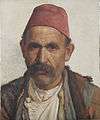Simon Agopyan
| Simon Agopyan | |
|---|---|
|
| |
| Born |
1857 Constantinople, Ottoman Empire |
| Died |
16 May 1921 Constantinople, Ottoman Empire |
| Nationality | Armenian |
| Education | State Fine Arts School (Ottoman Empire) |
Simon Agopyan (Armenian: Սիմոն Հակոբյան; 1857 - 16 May 1921) was a prominent Ottoman landscape and portrait painter of Armenian descent.[1]
Life

Simon Agopyan was born in Samatya, a district in Constantinople in 1857.[2] He completed his early education at the Horenyan School in Narlikapi and the Sahakyan School in Samatya. He took private lessons from the respect Armenian painter Telemak Ekserciyan and entered the Academy of Fine Arts in 1994, graduating in 1888.[1] While studying at the Academy, Agopyan was classmates with Armenian painter Arshak Fetvadjian.[2] Upon graduation, Agopyan was awarded first place for a large painting entitled The Imperial Gallery at Eminonu which he executed for his finals.[1] This painting was later purchased by Alexander Vallaury, an architect of the late Ottoman period. He continued his work in his studio in Samatya until 1895, and from then on worked in Beyoğlu. His address was 48 Rue Kechich, Feriköy.[3]
From 1883 onward, Agopyan taught art at the Berberyan and Mezburyan schools in Üsküdar, and at the Esayan School near Taksim Square.[1] In 1911 his studio was above the Apollan Photography Studio, and one of the portraits commissioned by Apollon was that of Mehmed Resad which is in the Military Museum in Istanbul. He gave art lessons to the Ottoman princes and other amateurs, and one of his pupils was the painter Vahram Manavyan.[1] An exhibition of his work was help at Angelidis, a shop at 331 Cadde-i Kebir in Beyoğlu in 1896, and his works were last exhibited at the Societa Italiana. He won a prize at the Marseille Exhibition for a portrait of his father.[1]
Simon Agopyan died on 16 May 1921 and is buried at the Şişli Armenian Cemetery.[2]
Works
Important works by Agopyan include The Beggar from Van, Porters Crossing the Bridge in Karaköy, A Muslim Beggar, Turkish Neighborhood, Portrait of Sultan Abdulhamit II, and the Selamlik of Sultan Abdülaziz in Ortaköy (which was sold at an auction of Islamic art held by Ader Picard Tajan in Paris on November 18, 1988), six scenes of the Victory won by Gazi Ahmed Muhtar Pasa, The Medresse of Sofulu Seyyif Mehmed Pasa Mosque in Kadirga, a portrait of educationalist Reteos Berberian, A Dervish Beggar in the Courtyard of Mihrimah Sultan Mosque in Üsküdar (1911), and a portrait of Mahrukizade Cafer Bey (1894; which is owned by his grandson Cem Mahruki). He painted a series of Ottoman military successes in his Six Scenes of Victories of Gazi Ahmed Muhtar Paşa on the Eastern Front (1910) which was commissioned by Ahmed Muhtar Pasha’s family.[2]
He also has paintings of Istanbul tradespeople such as simit sellers, fishmongers, and chimney sweepers. Agopyan also painted religious subjects. Examples of the latter are those portraying two of the apostles, Timothy and Parthugiemeos (1888; which he did for the Surp Kevork Church in Samatya).
Gallery
 Hamals on the Karaköy Bridge
Hamals on the Karaköy Bridge Portrait of a Hamal from Moush
Portrait of a Hamal from Moush The Entrance of the Souks in Constantinople
The Entrance of the Souks in Constantinople Fighting around Shipka, August 1877
Fighting around Shipka, August 1877 Observing the actions around Ala Dagh, June 21, 1877
Observing the actions around Ala Dagh, June 21, 1877 Night Attack at Plevna
Night Attack at Plevna
References
- 1 2 3 4 5 6 Kurkman, Garo (2004). Armenian painters in the Ottoman empire 1600-1923. İstanbul: Matüsalem Publications. ISBN 9789759201555.
- 1 2 3 4 Davidian, Vazken Khachig (2014). "Portrait of an Ottoman Armenian Artist of Constantinople". Études arméniennes contemporaines. 4: 11–54.
- ↑ Annuaire oriental du commerce, de l'industrie, de l'administration et de la magistrature years 1909, 1913, and 1921